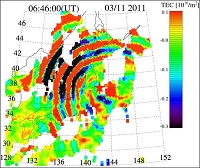This is an archive of information released in the past.
Disclaimer: It may contain broken links or outdated information. Some parts may not function in current web browsers.
*Visit https://humans-in-space.jaxa.jp/en/ for the latest information.

Experiment
- News
- Kibo Utilization Strategy
- Kibo Utilization Plan
- List of JAXA's Utilization Themes
- Experiment Facilities
- Space Environment Utilization
- Archive
Earth Science and Earth Observation Field
Recently, changes in the Earth's environment, believed to be a result of human activities, such as, deforestations as symbolized by the destruction of the rainforests, as well as, the depletion of the ozone layer by CFC gases, has become alarming issues. In addition, today's modern society is always under constant threat from nature, such as earthquakes, volcanic eruptions and El Nino. In order to maintain the Earth's environment and for society to be in harmony with nature, it is essential to understand the mechanisms of these phenomena by understanding the current situations that result in environmental destruction and changes in the environment. Furthermore, it is essential to develop a global model based on the obtained data. This model would be used to predict possible climatic changes by conducting climate change simulations. The next step would be to then utilize the predicted information. In order to do this, wide-ranging and highly frequent global observation becomes important. Observation from space is one of the most effective methods.
JAXA (and the former NASDA) has launched the following Earth observation satellites as represented by:
- Geostationary Meteorological Satellites (Himawari series 1-8: 1977-present)
- Marine Observation Satellites 1, 1b (MOS-1, 1b: 1987, 1990)
- Tropical Rainfall Measuring Mission (TRMM: 1997)
- Advanced Land Observing Satellites (ALOS: 2006, ALOS-2: 2014)
- Global Change Observation Mission(GCOM-W1: 2012)
The observation systems and sensors utilized in these satellites involved many new and advanced elementary technologies. It is important that the functions and capabilities of those technologies are properly demonstrated and certified before they are used in operational satellites.
The advantages of utilizing the Japanese Experiment Module Kibo's Exposed Facility of the ISS includes: a) long term observation from a low orbital altitude, which is difficult to achieve with regular satellites; b) observation covering a wide range of latitude from a high inclination; c) capability to replace and maintain equipments on orbit as provided by support from human space flights. Since the start of Kibo's operation in March 2008, the following earth science and observation missions have been conducted:
- Space Environment Data Acquisition equipment (SEDA-AP)
- Superconducting Submillimeter-Wave Limb-Emission Sounder (SMILES)
- Ionosphere, Mesosphere, upper Atomosphere, and Plasmasphere mapping (IMAP)
- Global Lightning and Sprite Measurement Mission (GLIMS)
- Assessment of Commercial-off-the-shelf, high definition television camera under exposed environment (COTS HDTV-EF)
Other related missions performed on the ISS are as follows.
| Copyright 2007 Japan Aerospace Exploration Agency | Site Policy |

